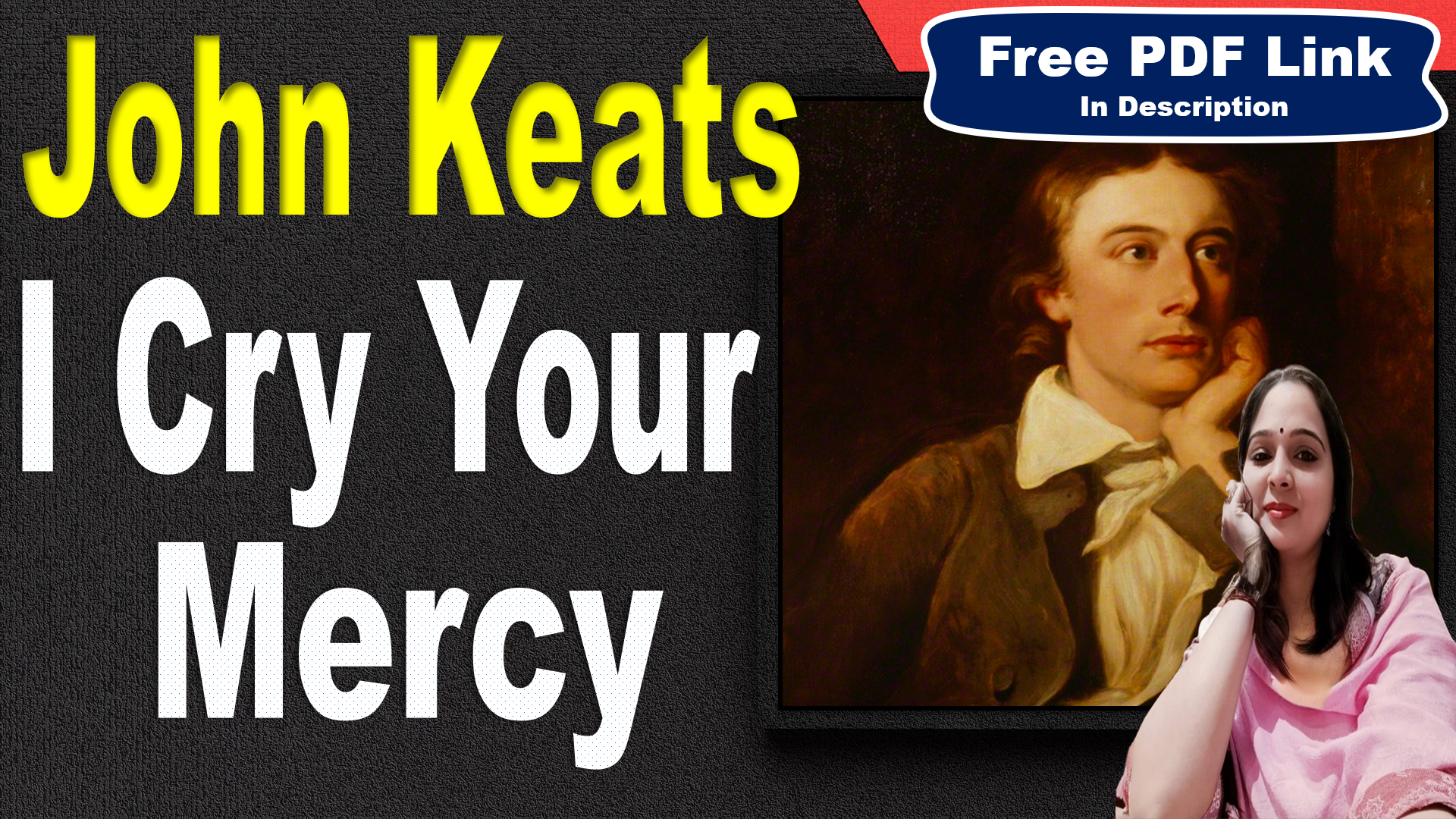I Cry Your Mercy Pity Love Summary
The poem I Cry Your Mercy—Pity—Love!—aye, Love by John Keats is thought to have been written around 1819, a time when Keats was very productive. It was published after his death in 1848 in the book Life, Letters, and Literary Remains of John Keats, edited by Richard Monckton Milnes (later Lord Houghton). This publication helped draw more attention to Keats’s lesser-known poems and played an important role in establishing him as an important Romantic poet.
In I Cry Your Mercy—Pity—Love!—Aye, Love!, John Keats expresses a deep longing for a love that is pure, complete, and unconditional. The speaker passionately asks for a love that goes beyond the surface, desiring a connection that joins body, mind, and soul. He describes this ideal love as “merciful” and honest—one that is sincere, without deception or hesitation. The speaker’s strong desire is clear when he says, “whole—all—all—be mine!” showing that he wants an all-encompassing and total bond with his beloved.
Keats shows the speaker’s desperation and vulnerability through his appeal for every part of his lover—her “hands,” “eyes,” and even her “soul.” He doesn’t want just a partial or uncertain love, but instead seeks full commitment, as anything less would be unbearable. For him, love must be pure and honest, free of doubt or hesitation. His repeated words like “all” and “whole” highlight his wish for complete intimacy, with no part of love or devotion held back.
The speaker knows the stakes are high; without this kind of love, he fears falling into sadness and feeling like a “thrall” or slave to his unfulfilled desires. Without true love, he imagines his life losing its purpose, his goals fading, and his mind growing dull. The speaker suggests that love is more than just happiness—it is essential for giving life meaning and depth. Without it, he fears being trapped in a state of “idle misery,” where life’s excitement and joy would disappear, and his once-strong ambition would become lifeless.
In the end, Keats’s poem reflects the Romantic belief that love is an essential, life-giving force. It is a plea for a deep and total connection that goes beyond physical attraction, becoming a source of purpose and passion. The speaker’s heartfelt appeal embodies the Romantic quest for an absolute, unwavering love that is vital for a meaningful life.
Key Points
Author John Keats was an English Romantic poet (1795-1821) who focused on themes of beauty, love, and the temporary nature of life. He aimed to capture deep emotions in his poems, highlighting the spiritual and emotional experiences of being human.
Form and Rhyme Scheme: The poem is a Shakespearean sonnet with 14 lines divided into three sets of four lines (quatrains) and a final two-line couplet. Rhyme Scheme: The poem follows the ABAB CDCD EFEF GG pattern, which is typical for a Shakespearean sonnet, creating a structured and rhythmic flow that adds to the speaker’s intense emotions.
Speaker
Identity: The speaker is someone deeply in love and longing for a complete, all-consuming relationship. He shows vulnerability and dependence on this love.
Perspective: The speaker looks inward, thinking about his strong desires and what could happen if his love isn’t returned.
Setting
The poem doesn’t describe a physical place but instead is set in the speaker’s mind as he experiences deep longing and desire.
Theme
Love and Desire: The main theme is the speaker’s intense wish for a complete and pure love that includes both body and soul.
Emotional Dependency: The speaker feels that his entire happiness and life’s purpose rely on being fully connected to his beloved.
Despair and Unfulfilled Love: Another theme is the sadness and emptiness he fears if he can’t have the love he longs for.
Plot
Opening Plea: The poem begins with the speaker begging for mercy, pity, and love from his beloved.
Desire for Completeness: He expresses a strong desire for a love that is complete and sincere, wanting all of his beloved.
Fear of Unfulfilled Love: The speaker worries that if his beloved holds back, he will either die or live as a miserable servant to unfulfilled desires.
Sense of Emptiness: In the final couplet, he imagines that without this love, he will lose his sense of purpose, and his mind and ambitions will become dull and lifeless.
Tone
Passionate: The speaker’s tone is full of intense feeling, showing how deeply he desires this love.
Desperate: There is a strong sense of desperation as he talks about the possibility of living in misery if his love is not returned.
Vulnerable: The speaker shows his emotions openly, revealing how dependent he is on his beloved’s love.
Style
Romantic Style: The poem reflects Romantic ideals, focusing on deep personal emotions, the wish for transcendent love, and the beauty of sincere affection.
Rich Imagery: Keats uses vivid images like “warm, white, lucent” to create a strong picture of his beloved.
Figurative Language: The poem uses metaphors, exaggeration, and personification to show the depth of the speaker’s longing and the pain of unfulfilled love.
Message
The Need for Complete Love: Keats shows that love must be complete and unconditional to be truly fulfilling. Anything less leaves the lover feeling empty and sad.
Dependence on Love for Purpose: The poem suggests that love gives life meaning and energy. Without it, a person’s ambition and joy can fade away.
Warning About Incomplete Love: Through the speaker’s experience, Keats warns about the emotional pain that comes from partial or unfulfilled love, highlighting how love can bring both joy and deep sadness.
John Keats
Early Life
John Keats was born on October 31, 1795, in London, England, to a working-class family. He was the oldest of four surviving children. At age eight, he lost his father in a riding accident, and when he was 14, his mother died of tuberculosis. Despite these hardships, Keats showed a strong interest in literature early on. He trained as a surgeon but soon focused on writing poetry, which he loved more than medicine.
Literary Career
Keats started writing poetry in his late teens, inspired by poets like Lord Byron and Percy Bysshe Shelley, and influenced by mythology and Renaissance literature. His first poem, “O Solitude,” was published in 1816. Encouraged by his friend Leigh Hunt, Keats joined London’s literary circles. His early work, such as Endymion (1818), was criticized by conservative reviewers, but he continued writing and created his best poems in just a few years.
Major Works
Keats’s most famous poems, like “Ode to a Nightingale,” “Ode on a Grecian Urn,” “To Autumn,” and “Bright Star,” were written between 1818 and 1820. These poems explore themes of beauty, change, love, and death, using rich imagery and deep thoughts. Keats’s odes are considered some of the best in English literature and show his ability to mix sensory detail with deep emotion and insight.
Themes and Style
Keats’s poems are known for their detailed imagery, emotional depth, and themes of beauty, love, death, and life’s shortness. His writing reflects the Romantic style, highlighting personal feelings, nature’s beauty, and deep truths. He believed in “Negative Capability,” which means being comfortable with mystery and uncertainty without needing clear answers. This idea allowed him to write poems that left readers feeling a sense of wonder.
Personal Challenges and Health
Keats faced many personal struggles. His family, including his younger brother Tom, died from tuberculosis, and Keats himself later became sick with the same disease. He fell in love with Fanny Brawne but was too sick and poor to marry her. His health worsened, and in 1820, he moved to Rome, hoping for a recovery in the warmer weather, but his condition quickly got worse.
Death and Legacy
John Keats died in Rome on February 23, 1821, at just 25 years old. During his life, his work was not well-known, and he feared he would be forgotten, as shown in his epitaph: “Here lies one whose name was writ in water.” However, after his death, Keats’s reputation grew. Today, he is celebrated as one of the greatest Romantic poets, known for his beautiful language, emotional power, and thoughtful ideas.
Influence and Legacy
Keats’s poetry continues to inspire readers and writers, focusing on beauty, deep emotions, and life’s temporary nature. His Romantic ideas and rich sensory details made him an influential figure in literature. Although he lived a short life, Keats’s impact on poetry and art has been significant, and he is remembered as a poet who greatly influenced the Romantic movement.
Word Meaning
| Tough Word | Meaning in English | Meaning in Hindi |
| Mercy | Compassion or forgiveness shown towards someone | दया |
| Pity | Feeling of sorrow and compassion for someone’s suffering | करुणा / सहानुभूति |
| Aye | Yes, indeed | हाँ, अवश्य |
| Tantalizes | Torments or teases with something unattainable | ललचाना / तरसाना |
| Thoughted | Full of thought or consideration | विचारशील |
| Wandering | Moving from place to place without a fixed course | भटकना / भ्रमण करना |
| Guileless | Innocent and without deception | निष्कपट |
| Blot | A stain or blemish | दाग / कलंक |
| Thee | An old English word for ‘you’ | तुम / तुझे / तुम्हें |
| Zest | Great enthusiasm and energy | उमंग / जोश |
| Lucent | Glowing with light or shining | चमकीला / प्रकाशमान |
| Million-pleasured breast | A heart full of countless joys | लाखों आनंद से भरा हृदय |
| Withhold | To hold back or refuse to give | रोकना / वापस लेना |
| Wretched | In a very unhappy or unfortunate state | दयनीय / दुखी |
| Thrall | A state of being in someone’s power or having great power over someone | ग़ुलामी / वश में होना |
| Mist | A cloud of tiny water droplets or metaphorically, confusion | कुहासा / धुंध, भ्रम |
| Idle misery | A state of pointless suffering | निरर्थक दुख |
| Palate | Sense of taste | स्वादेंद्रिय |
| Gust | A brief, strong rush of wind or a burst of feeling | झोंका / प्रचंड भावना |










